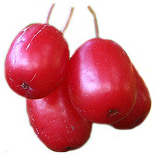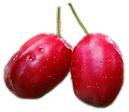

Cornelian Cherry

Cornus. DOGWOOD; CORNEL. (Latin name for Cornus mas.) Cornaceae. Some 45 species of perennial, semi-woody herbs, shrubs or small trees, deciduous or sometimes evergreen. Leaves opposite or sometimes alternate, simple, entire, with prominent venation, sometimes adpressed-pubescent. Inflorescence of terminal cymes, umbels, panicles or compact heads; bracts 1-4; flowers usually bisexual, white, green-white or yellow, small. Fruit a drupe, bilocular, 2-seeded. Temperate regions of the N hemisphere; rare in S America and Africa. CultivationAn outstanding genus of mainly woody plants, extensively cultivated for a wide range of ornamental effects. Dogwoods such as Cornus alba and its many cultivars and Cornus stolonifera are invaluable for their winter beauty, having brilliant autumn foliage, handsome fruits and colourful stems which range from yellow through brilliant crimson to almost black-purple. Many other species have attractive autumn fruits, these may be white, blue, or in shades of red through to black. The flowering dogwoods such as Cornus florida, Cornus kousa and Cornus nuttallii are also grown for their stunning autumn colour but it is for their large white or pink bracts, in early summer, that they are celebrated. Cornus mas is valued as an early spring-flowering shrub, when its leafless branches are covered with a profusion of small yellow flowers. The only non-woody species commonly grown is Cornus canadensis, which forms an attractive carpet of creeping stems, with white-bracted flowers in summer and red fruits in autumn. Most species can cope with minimum winter temperatures of between -10ºC and -25ºC, while Cornus capitata, Cornus chinensis and Cornus oblonga are only hardy in milder areas where the minimum temperature does not fall below -5ºC. Cornus florida and Cornus nuttallii will tolerate low temperature, but need long, hot humid summers to promote the best growth; in cool temperate maritime climates, prolonged and erratic springs may also damage their decorative bracts. Hybrids with Cornus kousa, especially Cornus ‘Eddie’s White Wonder’, are valued for their improved hardiness. They thrive in a wide range of soil types from acid through to thin chalky soils. Many of the coloured stemmed dogwoods grow in poorly drained soils and are effective, therefore, in waterside plantings. For effective and colourful stems in winter, cut Cornus alba hard back in spring, to within 5cm of the ground, or grow as a low pollard or stub. Cornus species alternifolia, controversa, florida and nuttallii all have gracfully tiered habits that should be left untouched. Seed of Cornus florida and Cornus kousa should be cold stratified when ripe and then spring sown. Many species and their cultivars can be increased by taking softwood cuttings in summer and rooted under mist, or in a closed case; young plants need protection of the cold frame over winter. Cornus alba and Cornus stolonifera and their cultivars are easily propagated by 20cm hardwood cuttings taken in autumn and rooted in open ground or a cold frame. Cornus macrophylla
Deciduous tree or tall shrub, to 15m, stems many; branches spreading, yellow-red. Leaves 10-17cm, elliptic-ovate to oblong, apex long-acuminate, dark lustrous green above, glaucous blue with sparse, silvery, adpressed, centrally attached hairs beneath, vein pairs 6-8; petiole to 3cm. Flowers yellow-white, 1-1.5cm diameter, in broad terminal cymes 8-15cm diameter. Fruit globose, blue, 6mm diameter, edible. Late summer. Himalaya, China, Japan. Z6. Cornus masCORNELIAN CHERRY; SORBET. Deciduous shrub with spreading habit, sometimes a small tree, to 5m. Young branches covered by grey-green pubescence. Leaves 4-10cm, ovate, apex acute, base tapered or rounded, dark green, adpressed pubescence above and beneath, vein pairs 3-5; petiole to 6mm. Flowers small, bright yellow in small precocious 2cm diameter, produced before leaves on previous year’s wood bracts, 4, downy, falling before flowers mature. Fruit 2cm, bright red, oblong. Spring. Europe, W Asia. forma sphaerocarpa. Fruit globose. ‘Alba’: fruit white. ‘Aurea’: leaves yellow. ‘Crispa’: leaves puckered and rolled. ‘Elegantissima’: leaves edged yellow, flushed pink. ‘Golden Glory’: leaves and fruit large, flowers larger, more profuse. ‘Lanceolata’: leaves narrow, edged white. ‘Nana’: dwarf spherical bush. ‘Pyramidalis’: growth upright and narrow. ‘Violacea’: fruit violet blue. ‘Xanthocarpa’: fruit yellow. Z5.
|
Home
Grow Herbs
Grow Nuts
Grow Vegetables
Cyberian Index
If you like this website and want one of your own contact
Cyberian All information correct at
time of publication and open to updates as necessary. No part of this website,
or its vectors, may be produced in any shape or form, using any type or design
of medium, system, equipment or otherwise without the prior written consensual
notice of the Cyberian. Any breach of these requirements will result in the
appropriate action. If in doubt, e-mail contact is recommended.
Some components of this website were obtained as open-source software and are
used in the same non-profit manner on this website.